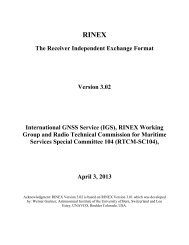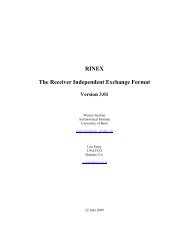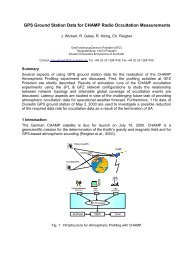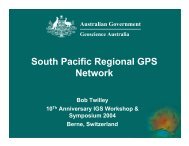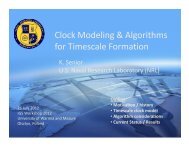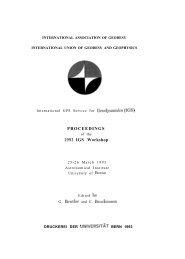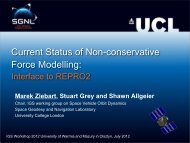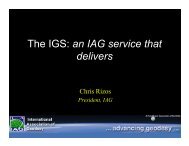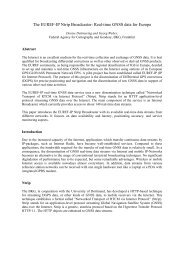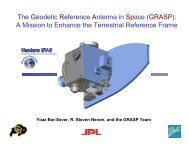..standard deviations. This is convenient for looking at an unfamiliar solution beforedeciding what to do with it (e.g., to perform some acceptance test). The disadvantageis that loose a priori constraints must be applied for every fiducial-free solution in orderto remove the rank deficiency problem when computing the covariance matrix. Anotherdisadvantage is that M must be inverted to form the weight matrix every time solutionsare combined. This is not as serious a disadvantage as it might seem at first, because inpractice, methods (b) and (c) below also require a matrix inversion if the solutions areto be checked prior to combination.Examples of systems that currently use representation (a) include STAMRG (and someother GIPSY modules) [~PL, 1993], and GLOBK (MIT program for combiningloosely constrained solutions from GPS and VLBI experiments [Herring, 1993; Dong,1993; Feigl et al., 1993].(b) A traditional representation in geodesy is the system of normal equations, includingthe coefficient matrix N = A~CA and the vector of normalized estimates u = ATCZ.This is more computationally efficient for combining solutions, since no inverses needto be calculated until the final solution is desired, Technically, no a priori constraintsare necessary until the last step; however, as pointed out above, it is likely that, inroutine operation, an inverse will be taken for purposes of acceptance testing.An example of systems that currently use representation (b) is the GFZ software [Zhuet al., 1993].Going from system (b) to system (a): M = N-l and x = N-lUGoing from system (a) to system (b): N = M-l and u = M -l X(c) A traditional representation in space navigation, closely related to (b), is the squareroot information formalism (SRIF) [Biennan, 1977], including information matrix R =HA, where H is a householder transformation designed to make R upper triangular,and the vector of normalized estimates y = Hz. This is the most numerically stablerepresentation. When using normal equations, a computational precision is required thatis equal to the square of that needed when using SRIF [Vanicek and Krakiws@,1986]. Like (b), no inversion is required until the last step, with the additionaladvantage that inversion can be very rapidly achieved using back substitution. Like(b), no a priori constraints need be imposed until the last step, but unlike (b), validsolutions can be computed for observable parameters even if rank deficiencies exist.Partial inversion for a subset of parameters is easy (by inverting only the lower righthand corner). It is less convenient than (a) for preliminruy acceptance testing, butconversion to (a) is computationally quick (see below).Examples of systems that currently use representation (c) include AMBIGON (andsome other GIPSY modules) [Blewitf, 1989]. The SRIF method was used to combineglobal and regional GPS solutions by Lindqwister et al. [1991]. Although the GIPSYmodule for network combination (STAMRG) currently exchanges files inrepresentation (a), all internal computations are done after conversion to (c).9Going from system (c) to system (a): M = R -l (R - l)T and x = R-l yGoing from system (c) to system (b): N = R T R and u = RTY9JpL “se. Bjem~ns~ )Z~timation subr~”ti~~ ~lb~~~ (“EsL”’, public dorn~n, FORW) to ~flollll thesquare-root factorization in going from system (a) to system (c), and the back substitution for R] [Biennun,1977].75
3.4 Format of submitted solutionsWe acknowledge that there is work in progress by several individuals on working towardsa universally acceptable solution format (J.T, Freymueller, T. Herring, R.W, King, and R.Noomen, private comm.). Rather than explicitly define a format, we prefer at this point tolist the information content that we think the file ought to contain. For now, we discussonly GPS solutions, but it should be a relatively small step to allow, for example, VLBI,SLR, LLR, trilateration, and triangulation solutions. For all techniques, our previouscomments on the importance of fiducial-free solutions are relevant (for example, no datumconstraints in the case of traditional geodesy). The following guidelines have been writtenfor representation (a) above, but can be easily adapted for representations (b) and (c). Werecommend that:(i) The format be ASCII, with up to 80 characters per line.(ii) The covariance matrix be represented as an upper triangular correlation matrix wherethe diagonal elements are the standard deviations. The upper triangular array is written outcolumn by column (write column i for all rows 1 to i before moving to column i+ 1 ) sothat the position of the matrix element is independent of the number of parameters. Sinceparameters can be very correlated in free-network solutions, correlation coefficients shouldbe quoted to 15 significant digits.(iii) Each component of the estimate vector be the w estimate, meaning that it is the apriori plus the delta estimate. This approach is attractive since it is likely that differentgroups will use different a priori values, and we only need to know the full estimate whencombining solutions. (assuming they are close enough for validity of linearity), and (q%when a new station comes on line). For the record, a priori values and their constraints (apriori standard deviations) should also be stored in the file. This might be useful, forexample, if it is suspected that the basic assumption of linearity might be violated, or if apriori constraints might have had a significant and undesirable effect.(iv) The estimate refer to the monument, except for those cases where the ARP (antennareference point) is defined to be the monument.(v) The basic unit be the meter for coordinates, radians for X and Y polar motion, andseconds for LODR.(vi) Each file include for every station identifier the eccentricity vector from the monumentto the ARP, and the assumed LC phase center offset, and the starting date for thisinformation (to allow for changes in antennas). This information needs to be givenexplicitly because eccentricity vectors and phase center offsets may be in error, may beinconsistent between groups, or may get updated by new surveys or antennameasurements. In addition, a flag can be optionally set to indicate any removal ofredundant information (as explained towards the end of item vii below).(vii) Standard 6-character station identifiers be used in the station coordinate parameternames. Characters 1-4 should uniquely identify the monument. Characters 5-6 should bean “occupation number,” used to force separate solutions for different epochs. In thecontext of permanent networks, the “occupation number” needs to be changed only if thestation undergoes co-seismic displacement, or if the antenna is moved or changed. In thetraditional context of field campaigns, this number might be used to identify experimentnumber. Note that every 6-character station identifier must have the information specifiedin item (vi) above. Note also, that if the antenna offset is changed in a known way, thenthis constraint can be applied as a last step. In the limit that the offset change is perfectly76
- Page 1 and 2:
●INTERNATIONAL ASSOCIATION OF GEO
- Page 3 and 4:
TABLE OF CONTENTS.FINAL AGENDA . .
- Page 5 and 6:
13:30 NGS14:00 S1014:30 EMR15:00 CO
- Page 7 and 8:
LIST OF PARTICIPANTS:Prof. Gerhard
- Page 10 and 11:
Table 1. Current IGS Analysis Cente
- Page 12 and 13:
The first field identifies the reco
- Page 14 and 15:
Summary InformationThe third produc
- Page 16 and 17:
From Figure 1 we find that there ar
- Page 18:
to define a reference clock in thei
- Page 22 and 23:
SESSION 2(IGS orbit products)
- Page 24 and 25:
1. introductionThe main objectives
- Page 26 and 27:
ecause of the above averaging. This
- Page 28 and 29: RMS per center (m)o 0 0 0 0 0 oA0Iv
- Page 30: Scale (ppb)I I I I I 11+-b~ul0Amo&I
- Page 33 and 34: and NGS. Note that the day to day v
- Page 35 and 36: Rotation around X-axis (mas)1&0 0o
- Page 37 and 38: discussed in Section 3 are here see
- Page 39 and 40: -----------------------------------
- Page 41 and 42: Residuals in Meters1 1 1 1 1 1 1=%m
- Page 43 and 44: Residuals inMeters11111cnficJJw-o A
- Page 45 and 46: I I I—Residuals in Meters..—.
- Page 47 and 48: 1111ResidualsMeters,—{44
- Page 49 and 50: Residuals in MetersI I I II I I IIc
- Page 51 and 52: Rms in MetersI 1 ! I 1 10 n0 a0n.ff
- Page 53 and 54: IGS- and the COM-sets, but that the
- Page 55 and 56: Table 4.1 N.A. Baseline Repeatabili
- Page 57 and 58: ..Figure 5.1:Clock solutions for FA
- Page 59 and 60: specifically the preanalysis can be
- Page 61 and 62: discussion, a question as to whethe
- Page 63 and 64: SUMMARY OF SESSION 3This Session be
- Page 65 and 66: IGS POSITION PAPER, IGS ANALYSIS CE
- Page 67 and 68: and Earth orientation parameters (E
- Page 69 and 70: LbPIERS and IGSCentral Bureausand D
- Page 71 and 72: @ IGS will develop instructions, an
- Page 73: 2.2 Analysis Center System DesignFi
- Page 76 and 77: applied to the solution in order to
- Page 80 and 81: known, the two solutions will be ad
- Page 82 and 83: errors, and can therefore be used a
- Page 84 and 85: International Terrestrial Reference
- Page 86 and 87: Thus, there is the potential of fee
- Page 88 and 89: 90” 100” 110” 120” 130” 1
- Page 91 and 92: adiation parameters for each satell
- Page 93 and 94: Bock, Y., R.I. Abbot, C.C. Counselm
- Page 95 and 96: SUMMARY OF SESSION 4This session st
- Page 97 and 98: INTERNATIONAL EARTH ROTATION SERVIC
- Page 99 and 100: x- differences with IERS0.001”I I
- Page 101 and 102: SUMMARY OF SESSION 5In the last ses
- Page 103 and 104: 1) I(X3 PROCESSING/REPORTS/FORMATSS
- Page 105 and 106: IGS should foster and encourage reg
- Page 107 and 108: ..INTERNATIONAL GPS SERVICE FORGEOD
- Page 109 and 110: ortL.s.4
- Page 111 and 112: 1234567a91011121314IsIt17ItIs2C2122
- Page 113 and 114: . Ruth Neilan16S Central BureauJet
- Page 115 and 116: ON1T.>● Jim ZumbergeJet Propulsio
- Page 117: PROPOSED ORGANIZATION OF THE INTERN




